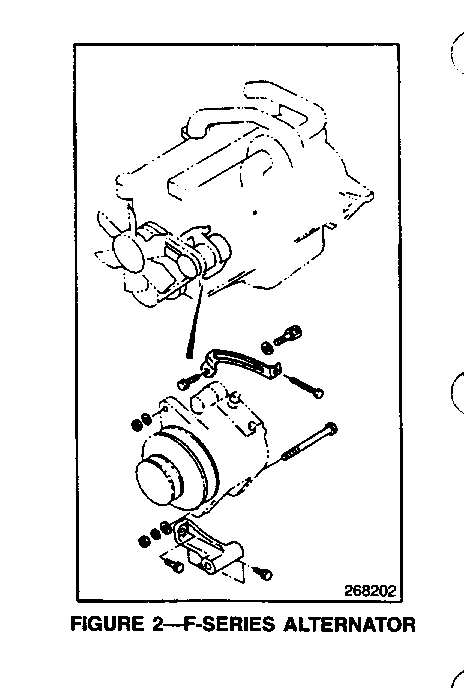ALTERNATOR SERV. INFORMATION (INSPECT SYSTEM CLOSELY)

SUBJECT: ALTERNATOR SERVICE INFORMATION
MODELS: 1993 AND PRIOR MODEL YEAR GMC FORWARD/CHEVROLET TILTMASTER MEDIUM DUTY TRUCKS
Alternators have been frequently replaced on Forward/Tiltmaster Medium Duty trucks and failure analysis has shown that in many cases alternators were replaced when no defect could be found with the alternator unit. In the cases where the alternator was found to be defective, improper installation of aftermarket equipment was often responsible for the failures.
Alternators are often relocated from original factory mounting position to gain clearance for aftermarket equipment. For example: air conditioner compressors, P.T.O.'s or other engine driven accessories. The design, fabrication, and installation integrity of the "modified" alternator mounting bracket and/or add on accessory is often undesirable from an alternator durability standpoint.
Structural failure of aftermarket mounting brackets, misaligned pulleys, loose belts and pulleys have been known to cause many problems including: alternator case fractures, alternator mounting lug elongation, vacuum pump oil supply line restriction or leakage, and water pump failure or leakage. These failures have led to major failures such as: engine seizure due to lack of lubricant, and/or engine overheating/seizure due to lack of coolant.
When alternator problems are noticed, be sure to inspect the system closely. The 1992 and 1993 ForwardfTiltmaster Manuals cover diagnosis of the charging system in section 6D-9. The 1992 and 1993 W5/W7HV Service Manuals cover diagnosis of the charging system in section 6D-6. In addition, there are several areas that need to be checked carefully, including:
Belt Tension: Insufficient tension due to loose bracketing. Insufficient tension causes slippage of the belt. Slippage results in overworking the charging circuit.
Alignment: Pulleys and belts that are not aligned will cause unnecessary wear and load on the alternator and assembly.
Vacuum Pump: The vacuum pump for the brake system is attached to the alternator (W4 and W5 model vehicles). Check oil supply and discharge lines for proper connection and inspect to be sure that there are no kinked lines or leaks in the system.
Mounting Brackets: Inspect all mounting brackets and hardware (figures 1 and 2, page 1) including tabs on alternator case. Check brackets for proper installation and inspect to insure that no cracks, fatigue, or physical damage has occurred.
Observe the alternator with the engine running to be sure there is no excessive vibration or motion and listen for squeal or other abnormal noises.
Careful inspection will improve customer satisfaction by reducing repeat failures which are often associated with modified engine driven accessories. A relocated alternator gives a clue to after-market modifications. Any vehicle where the alternator has been moved from the original factory location is a prime candidate for alternator problems. If problems are identified, repairs should be made to eliminate potential for future failure. Expenses incurred in these repairs shall be the responsibility of the owner or the modifier.


General Motors bulletins are intended for use by professional technicians, not a "do-it-yourselfer". They are written to inform those technicians of conditions that may occur on some vehicles, or to provide information that could assist in the proper service of a vehicle. Properly trained technicians have the equipment, tools, safety instructions and know-how to do a job properly and safely. If a condition is described, do not assume that the bulletin applies to your vehicle, or that your vehicle will have that condition. See a General Motors dealer servicing your brand of General Motors vehicle for information on whether your vehicle may benefit from the information.
